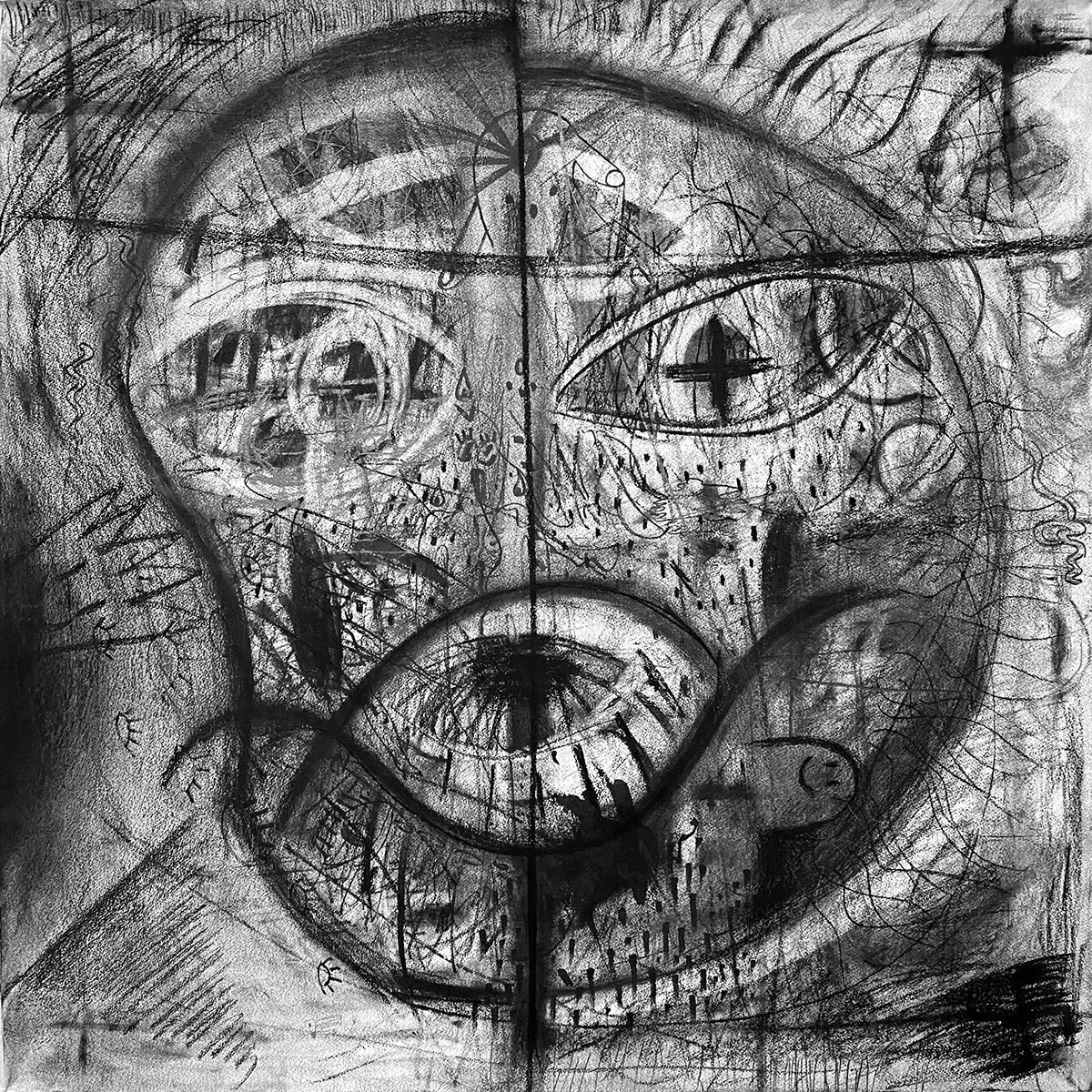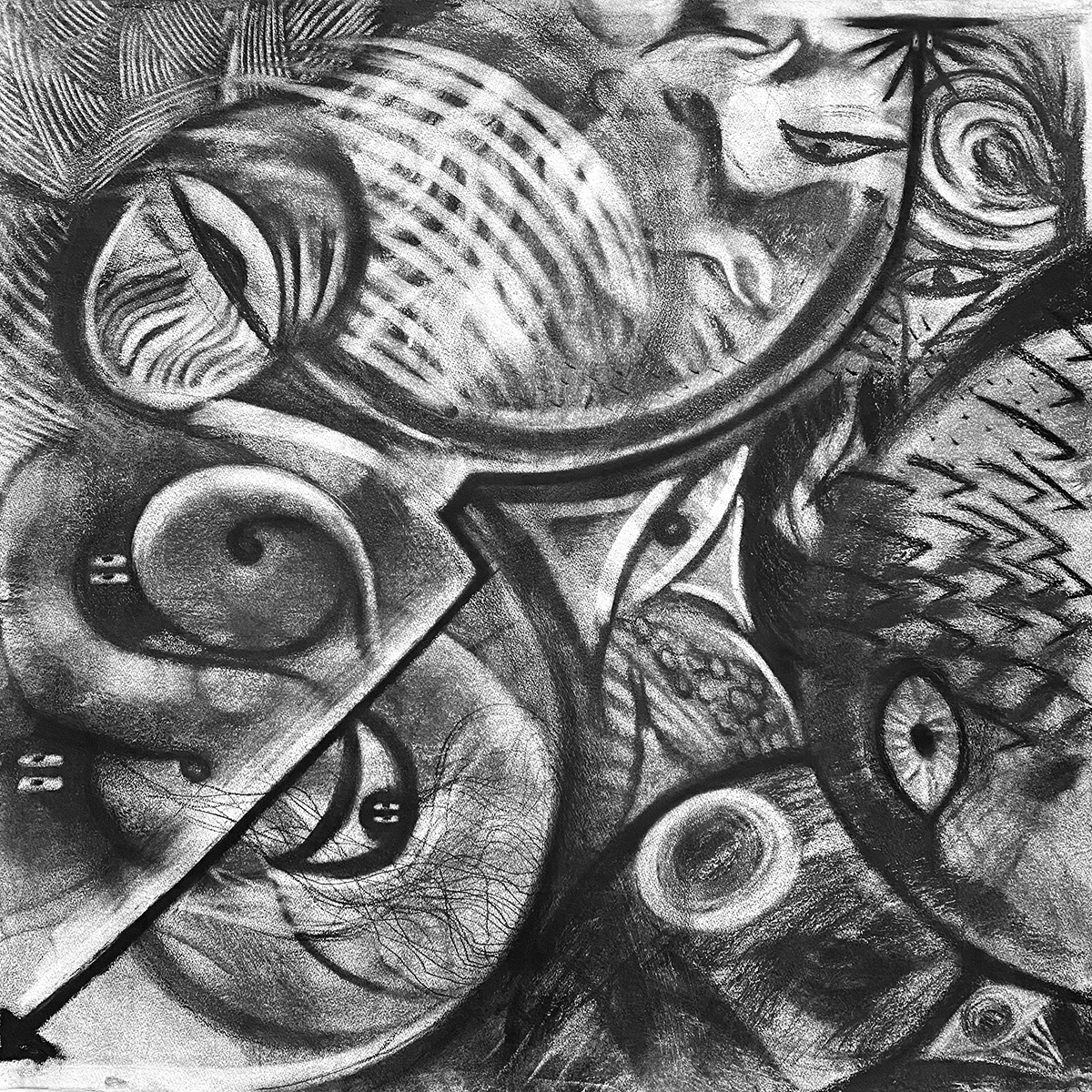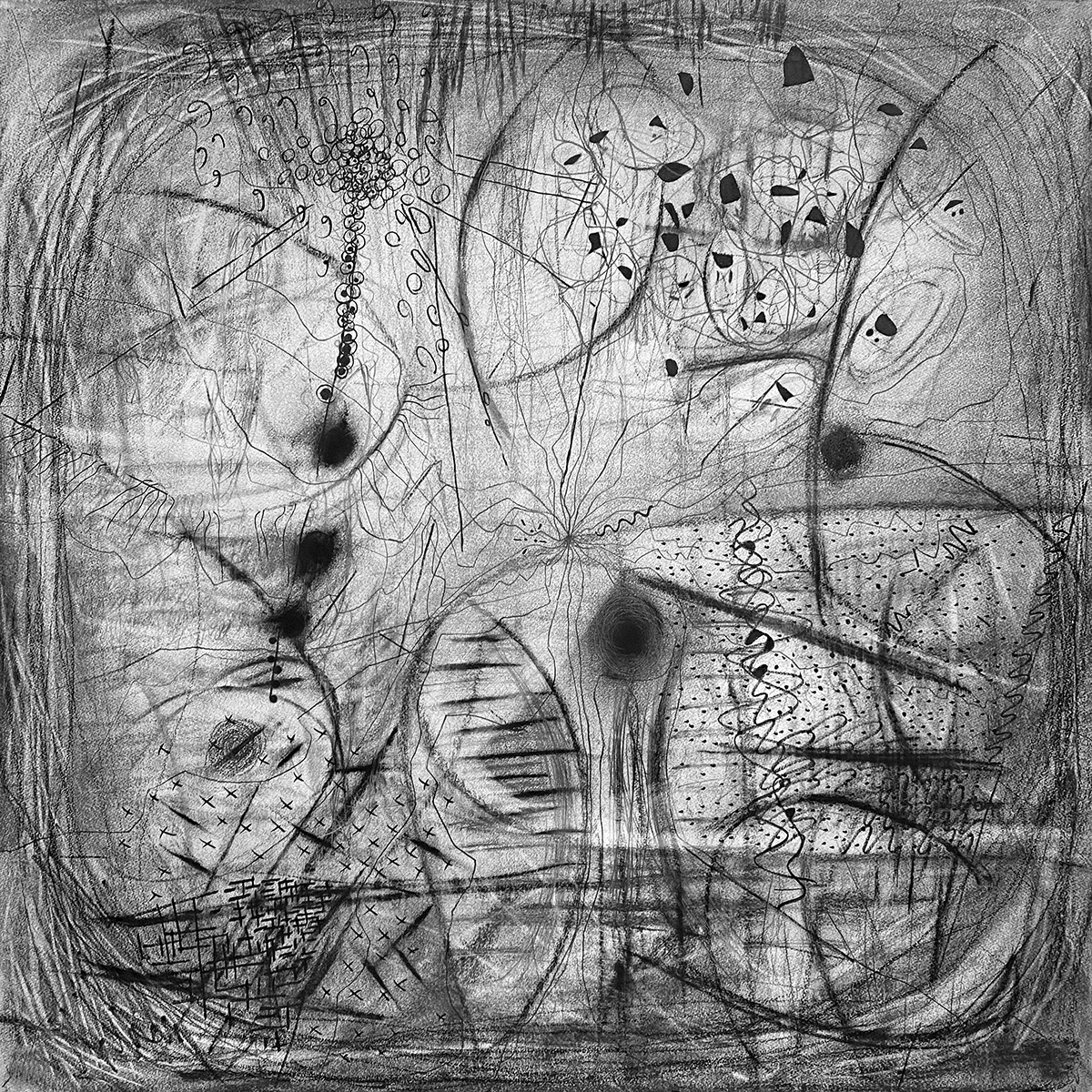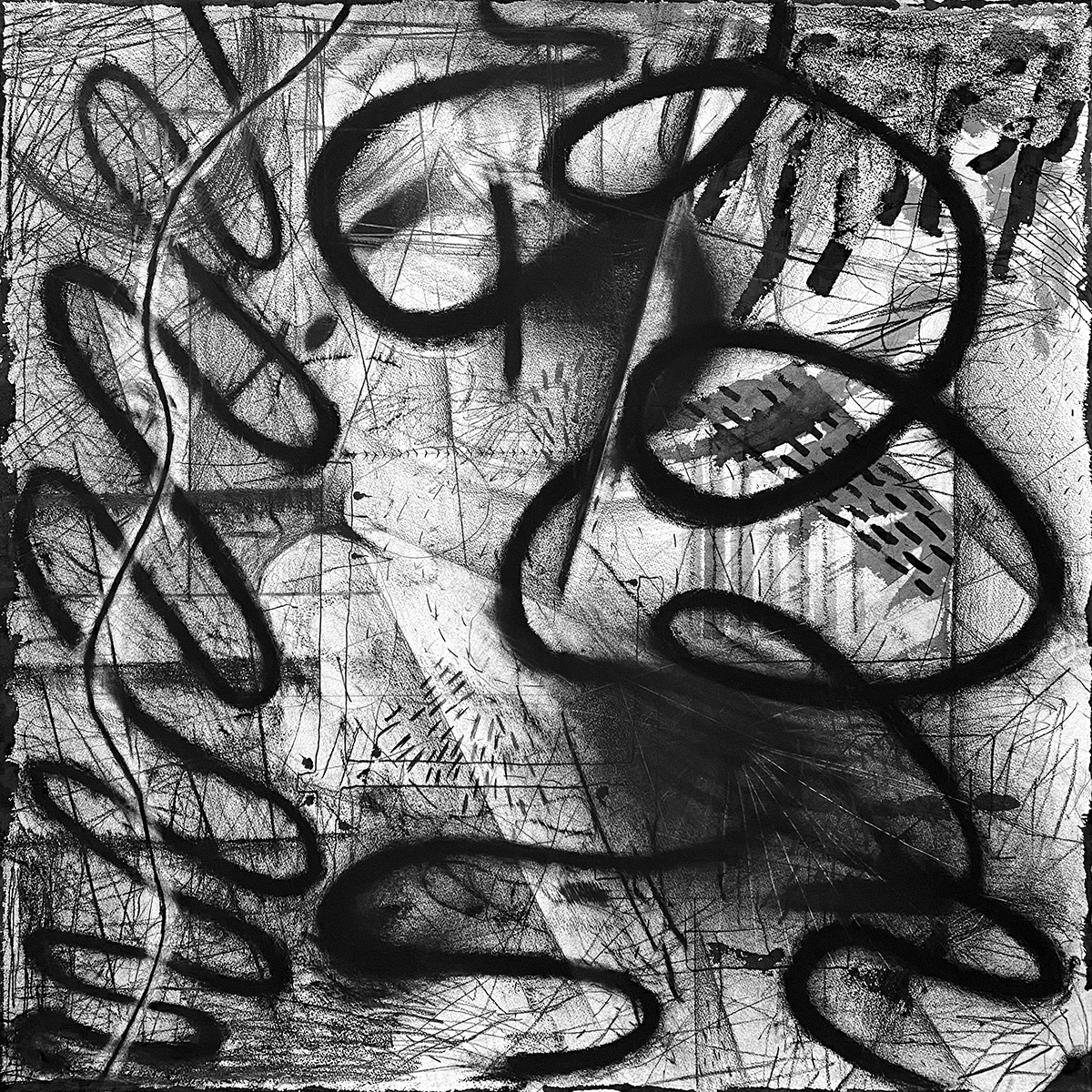Exhibition catalogue text
by Ariane Kupferman-Sutthavong
Un • learning
There is something ubiquitous, yet utterly absorbing, about the inception of Yujin Lee’s Bangkok exhibition Under the Rainbow. In many ways, it is a fairly ordinary tale, one that illustrates the volatility of life trajectories, artistic partnerships and the business of show-planning. Originally devised as a two-artist exhibition - a collaboration between Lee and her fellow Columbia University graduate Nicole Maloof - the show has morphed over the course of years, finally settling into its current form.
It is now a solo exhibition of course, the baseline of which is provided by Lee, but diverse actors (from a Thai-Korean interpreter to local guest artists, as well as regular visitors) are invited to steer it into new directions.
Under the Rainbow spans over six weeks. The exhibition’s duration is just a little under that of Yujin Lee’s stay in Thailand and acts as a record of the multiple processes the artist moves through in her overseas journey. As daily acts of drawing or engaging with others take on a different signification when set against a foreign, unfamiliar context, the gallery space is transformed into a base, which Lee regularly revisits and returns to. Her two performance-based works, Drawing Conversations 2.0 and Learning Thai may take place weekly within the exhibition areas, they are also the physical manifestations, as well as temporal markers of a wider set of interactions existing beyond the white cube. Through these works - halfway planned, leaving the other half to chance - the artist cultivates her taste for collaborative practices, embarking on a series of co-productions with near-strangers.
Just as the durational aspect and open-endedness of the works stand in contrast to many traditional or commercial shows, the exhibition’s lack of finality and clear purpose sets it even further apart, calling artistic production into question. By locating its opening date closer to the beginning of her Bangkok visit rather than its end, Lee undertakes what could be viewed as an anti art residency - or is it perhaps the ultimate art residency. The reversed timeline allows Under the Rainbow to act as a framework from which exchanges in three or more languages are derived instead of being directed at or feeding the more self-centered objective of a final show.
Ironically, Learning Thai, in which the artist meets each week with an interpreter to learn a Thai song, is a deeply selfish work (in the best possible sense). For there are few imaginable uses to being able to sing one song in a foreign language. Likewise, gallery visitors writing on a blackboard to recommend titles end up telling more about their personal desires to teach or share specific fragments of their local culture than they would imagine.
Drawing you in
The larger-than-life, monochromatic mural that greets the visitor’s eye upon entering the gallery is a ‘device’, as per the artist / an ‘interface’, as per this writer. A joined pair of hands arches above viewers, forming the initial contact point between the artist and ourselves. The drawing is absolutely silent but speaks of a song, and this tension lingers throughout the exhibition.
Inviting seven Thai artists to collaborate with her on six drawings on paper - each of them produced in publicly held sessions - Yujin Lee initiated a series of rules framing her ‘drawing conversations’.
Each invited artist is handed a tray containing a set of charcoal pencils, thus restricting their use of materials and colours.
Each session lasts 108 minutes - a number that refers to the Korean Buddhist custom of bowing 108 times, a meditative practice through which one rids oneself of attachment.
Each session is conducted in silence.
These arbitrary guidelines resemble the grammatical rules, as well as precepts - both explicit and tacit, mutually agreed on - one encounters in language or culture. While forming the backbone of social interactions, they may be reappropriated or individualised. The six ‘automatic’ drawings are processes during which the artists silently converse but also negotiate, at times resisting or adjusting to one another. A spatialisation of these exchanges, the outcomes reflect either a cacophony or quiet and intimate talk - sometimes both - as the participants upset each other’s trajectories or reciprocally complete their drawn sentences.
On a different level, Drawing Conversations 2.0 is Yujin Lee’s individualisation of the time-honoured practice of drawing. Trained at a young age in traditional arts, Lee makes use of her acquired rigour and discipline to perform a creative act during almost two hours. This performativity is however overturn by the open-endedness of her endeavour and her communicative bond with each invited artist - none of which are feigned. Organic and relatable, the pencil-drawn lines convey an intimacy that matches that of the artist’s bodily connection to her support.
Re • learning
In the beginning, there was…
Traces of Yujin Lee’s past collaborations with Maloof subtly bookend the exhibition. While previous works they had produced together explored their shared and divergent identities - respectively as a Korean and Korean-born, American adoptee - the central question to their would-be show in Bangkok was always: how do these affiliations translate to a third, somewhat neutral space? One route they had thought of following included the investigation of Asian identities and their (mis-)representations. Even as Maloof withdrew from participating in the exhibition, a remnant of their probe features in the gallery space in the form of a jab taken at colonial photography.
Ultimately, Under the Rainbow comes down to connections - bonds that are either lost or gained, spread thin or maintained through screens and social media in a globalised age. Everyday, we read and speak of a ‘hyper-connected’ world - so much that all interactions seem to be based off algorithms. The art world too, has its algorithms, differentiated networks that bring its actors from one part of the globe to another and introducing them to diverse yet corresponding sets of individuals.
Yet, Lee’s works leave room for fortuitous conversations - they are frames to be filled in or extended. Systems may set elements in motion, allowing for an exchange to take place; cultural and linguistic principles may guide interactions but for a dialogue to occur, individuals are still required to bridge the gap between them. Surveying this aperture, as Lee does, denotes a humble and open-minded posture. It also constitutes a shift from some of the previous attempts artists and theorists have made at ‘translating’ cultures and artistic practices. Never forceful, the exhibited works seemingly hover and drift in a multilayered landscape, where the specter of colonialism looms alongside snappy social media captions, and charcoal drawings as well as time-lapses capture conversations.
Three weeks into her temporary stay in Bangkok, I asked Yujin Lee what she had ‘learned’ so far during her visit. She replied that she was far more interested in the commonalities she found between herself and the individuals, places or situations she encountered than in their underlying differences. Under the Rainbow is whimsical and, interestingly enough, a case of art mimics life. Foregoing an anticipated collaboration and instead, setting about a series of collaborative practices with artists, gallerists and interpreters she had not previously met, the exhibition reflects the transient nature of such chance meetings - elements of which may forever be lost in translation.
Ariane Kupferman-Sutthavong (b. 1993 in Bangkok, Thailand) is a writer and curator whose interests lie in socio-political issues in Thailand and beyond, as well as global art-world dynamics. Through her writing and curated projects, she aims to create a platform for critical discussion regarding dominant narratives and framings. She holds an MA in Art and Politics from Goldsmiths, University of London.
전시 도록 평론
글. 아리안 쿠퍼만-숫타봉
반(反) • 학습
태국 방콕에서 열리는 이유진의 개인전 <무지개 아래>의 준비 과정은 그리 특별하지는 않지만, 관객을 완전히 몰입시키는 무언가가 있다. 어떻게 보면 변화무쌍한 인생 궤도, 창의적 협동 관계, 그리고 전시기획사업 등이 가지는 변동성에 관한 꽤 평범한 뒷이야기이기도 한데, 본래 컬럼비아 미술대학원 동기였던 니콜 말루프와의 2인전(혹은 협동 전시)으로 기획되었던 본 전시의 취지는 몇 년에 걸쳐 변형되어 마침내 현재의 모습으로 자리 잡게 된다.
기본적으로 이유진의 아이디어가 중심이 된 개인전의 형식을 갖추었지만, 전시는 결국 다양한 참여자들(방콕 출신 한인 통역사, 현지 예술가, 그리고 일반 관람객 등)에 의해 새로운 방향으로 이끌어진다.
작가의 태국 체류 기간보다 조금 짧은 6주 동안 진행될 <무지개 아래> 전시는 그가 객지인 태국에서 겪을 다채로운 여정의 기록이기도 하다. 작가에게 본래 익숙한 그림 그리기나 타인과의 관계 맺음도 낯선 환경에서는 또 다른 의미를 가질 수밖에 없어서인지, 전시장은 작가가 정기적으로 재방문하고 되돌아가는 베이스캠프가 된다. 매주 갤러리에서 펼쳐질 퍼포먼스 기반의 두 작품 <드로잉 談 2.0>과 <타이 배우기>는 화이트 큐브 공간 밖에 드넓게 실존하는 교감과 교류의 실체적 징후인 동시에 일시적 표식이다. 의도성과 우연성의 균형을 바탕으로 낯선 사람들과 함께 만들어나가야 하는 이 두 작품을 통해 이유진은 협동 작업에 대한 감각을 구축한다.
시간의 경과와 개방적 태도가 중요한 이유진의 작품들이 일반적인 상업 전시의 성격과 대조되는 것처럼, 종결성과 명확한 목적성이 결여된 그의 전시는 예술 작품의 제작과정에 대한 의문을 제기하며 더욱 극명한 차별점을 드러낸다. 작가는 방콕 체류 기간의 끝무렵이 아닌 시작점에서 전시를 개막함으로서 “반” 레지던시 혹은 가장 이상적인 레지던시를 시도하려는 듯한데, 이런 거꾸로된 타임라인으로 인해 <무지개 아래> 전시 속 다양한 언어의 교집합에서 파생될 그 무엇은 오로지 최종 전시를 위한 작가 중심적 목표에 종속되는 것이 아니라 하나의 기틀을 만들어나가는 과정에 이바지하게 된다.
역설적으로, 통역사를 동반하여 태국 노래 한 곡을 배우는 과정을 담은 <타이 배우기>는 (긍정적 의미에서) 매우 이기적인 작품이다. 외국어 노래 한 곡을 부를 수 있다고 해서 그 언어를 일상에서 써먹을 기회는 드물 것이기 때문이다. 마찬가지로 추천곡을 칠판에 쓰는 관람객의 행위는 현지 문화 중 특징적 일부를 공유하고 가르쳐주려는 지극히 개인적인 욕구를 반어적으로 드러내고 있다.
당신을 “그려”들이다
갤러리에 들어서는 관객을 정면에서 맞이하는 대형 모노크롬 벽화는 작가에 의하면 “장치"이고, 필자에게는 “교차점”이다. 한 쌍의 손이 결합하며 관객 위로 형성한 커다란 아치는 작가와 관객 사이의 첫 번째 접점이다. 벽화 드로잉은 과묵하면서도 선율적인 존재감으로 전시장 전체를 가득 채우며 잔잔한 긴장감을 조성한다.
<드로잉 談 2.0>에 초대된 7명의 태국 예술가들은 아래의 규칙에 따라 총 6장의 콜라보레이션 드로잉을 이유진과 함께 관객 앞에서 완성한다:
초대작가에게는 목탄과 연필 세트가 주어지며 드로잉에 사용할 수 있는 재료와 색상은 이에 제한된다.
각 드로잉 세션은 정확히 108분으로, 이 숫자는 한국 불교에서 108번 절을 하면서 108가지 번뇌에서 벗어난다는 의미에서 차용된 것이다.
각 세션은 침묵 하에 진행된다.
위와 같은 임의적 규칙들은 명시적이고 암묵적이며 상호 합의로 실천된다. 그것은 사회적 교류의 중추적인 역할을 하면서도 적절한 변형이나 개별화가 가능한 언어 혹은 문화적 문법과 흡사하다. 총 6회의 '오토매틱' 드로잉에 참여하는 예술가들은 무언의 대화 속에서 때로는 저항하고 때로는 적응하며 상대방과의 타협점을 찾아 나간다. 이러한 공간화된 소통의 결과물은 서로의 의도를 흐트러뜨리며 발생하는 불협화음이거나 상대방의 예술적 문맥을 완성해주는 고요하고 밀접한 대화, 혹은 둘 다일 수도 있겠다.
다른 관점에서 <드로잉 談 2.0>은 오랜 전통을 가진 소묘(素描)에 대한 이유진의 차별화된 해석이다. 그는 어렸을 때부터 전통 서양화 기법을 연마하면서 얻은 철저함과 절제력을 활용하여 두시간여동안 그림을 그리는데, 이러한 수행적 행위는 진정성을 바탕으로 한 그의 개방적 태도와 각 초대작가와의 예측할 수 없는 교감에 의해 다시 한번 전복된다. 이유진과 그의 협력자 사이의 육체적 유대감은 유기적인 연필의 선에서 공감과 친밀감으로 전해진다.
다시 • 배우기
태초에는...
이번 전시를 절묘하게 받쳐주고 있는 것은 이유진과 니콜 말루프의 이전 콜라보레이션이다. 그들은 협동 작업을 통해 한국인 그리고 한국계 미국 입양인으로서 서로의 정체성에 대한 공통점과 차이점을 탐구했다. 그리고 방콕에서 진행될 전시를 통해 어떻게하면 그런 연계지점들이 (한국도 미국도 아닌) 제3의 중립적인 장소에서 해석될 수 있을지에 대해 고민하였고, 그중 하나의 방안은 동양인에 대한 (잘못된) 묘사를 재점검해보는 것이었다. 말루프는 결국 본 전시에 참여하지 않았지만 그들의 본래 의도는 식민주의 시대 사진에 대한 비판적 입장을 표명하는 작품(Whisper)으로 전시장에 자리 잡고 있다.
궁극적으로 <무지개 아래>가 말하고자 하는 것은 “관계”이다. 세계화 시대에서 잃거나 얻는, 얇게 퍼지거나 스크린과 소셜 미디어를 통해 그저 연명(延命)해나가는 유대 관계 말이다. 우리가 매일같이 접하고 이야기하는 ‘초연결적인’ 세계에서는 마치 모든 상호관계가 알고리즘을 기반으로 하는 것처럼 보이는데, 예술계도 그들만의 알고리즘 혹은 차별화된 네트워크가 존재하며 이를 통해 예술인들은 전 지구를 활보하면서 다양한 듯 특정된 집단의 사람들과만 교류하게 된다.
하지만 이유진의 작품에는 우연적인 대화를 통해 채워지거나 확장될 여지가 남아있다. 여러 요소를 가동하는 그의 시스템은 교류의 장을 형성하지만, 결국 그런 교류를 유도하는 문화와 언어적 법칙을 넘어 개개인이 주체적으로 그들 사이를 갈라놓는 틈을 메워주어야만 진정한 대화가 이루어질 수 있다. 이유진이 인지해나가는 이러한 간극의 존재는 겸손과 열린 자세를 요구하는데, 여기서 이전 예술가들과 이론가들이 시도한 문화와 예술의 '번역'과의 차별점이 드러난다. SNS의 캡션과 목탄 드로잉 그리고 타임랩스 비디오 등 본 전시 속 작품들은 일체의 강요없이 복잡하게 얽힌 풍경 속에서 어렴풋이 기웃거리는 식민 시대의 넋과 함께 맴돌고 표류하고 있다.
작가가 방콕에서 생활한 지 3주가 된 시점에 나는 그에게 지금까지 무엇을 배웠는지 물었다. 그는 자신과 상대방 사이, 혹은 특정 장소와 상황들에서 발견된 익숙함이 근본적인 차이점보다 흥미로웠다고 대답했다. 흥미롭게도 그런 면에서 <무지개 아래>는 유머러스하게 삶을 모방한 예술이 되었다. 예정된 협업을 포기한 공백을 채운 것은 처음 만난 예술가들, 갤러리스트 그리고 통역사와의 또 다른 협업들이었다. 본 전시는 이 같은 우연한 만남의 과도기적 특성을 담고 있는데, 적어도 그 과정의 일부는 번역의 과정에서도 잃어버릴 수 없는 무엇이 아닐까.
아리안 쿠퍼만-숫타봉 (1993년생, 태국 방콕)은 태국 내외 사회 정치 이슈뿐만 아니라 국제 예술계의 역학에 주목하는 작가이자 기획자이다. 그의 목표는 글과 예술기획을 통해 지배적 담론과 틀에 관한 비판적 토론을 위한 플랫폼을 만드는 것이다. 그는 골드스미스 런던 대학교에서 미술과 정치학 석사를 취득했다.
การวาดภาพโดยอัตโนมัติ
โดย ออสติน โอ สแปร์ และ เฟรดเดอริค คาร์เตอร์
ภาพฝันและความทรงจำเกี่ยวกับทวยเทพ ล้วนถือกำเนิดขึ้นมาจากเลือดเนื้อของมารดาของพวกเราทุกคน นอกจากอิทธิพลอันเป็นผลจากความสนใจและความสามารถที่เพิ่มขึ้น ศิลปินทุกคนล้วนมีแรงกดดันอันต่อเนื่องบางอย่าง ที่พวกเขามักจะสัมผัสได้ แต่ก็มักจะไม่ได้มองเห็นอย่างแน่ชัด พวกเขามักจะได้เรียนรู้ในช่วงที่เริ่มต้นหรือช่วงบั้นปลายของชีวิตศิลปินว่าพลังในการผลิตซ้ำ (ดังที่มีอยู่ในอุปกรณ์การถ่ายภาพเป็นต้น) มีประโยชน์ต่อพวกเขาเพียงน้อยนิดเท่านั้น ศิลปินจะถูกกดดันให้สืบหาคำตอบจากศิลปินรุ่นพี่ ถึงตัวอย่างอันจับต้องได้ของการแทนที่ขนบเดิมๆ ด้วยสิ่งที่ดีกว่า เพื่อค้นพบกับความตื่นรู้ที่ถูกคัดสรรค์มาแล้ว และมักจะพอใจกับมัน ด้วยเหตุผลหลักๆ มาจากทัศนคติอันกว้างใหญ่ ที่มาพร้อมกับความตื่นรู้ที่ขยายขึ้น และซับซ้อนน้อยลง
หากแต่ยังมีพื้นที่ที่ยิ่งใหญ่กว่านี้ ซึ่งก็คือเพื่อการสำรวจ ศิลปินจะต้องจู่โจมความเข้าใจอันเป็นปรนัย และจะต้องใช้กลวิธีทางจิตใต้สำนึกเพื่อแก้ไขความไม่สมจริงในรูปลักษณ์อีกด้วย ต่อให้ใช้ทักษะทางฝีมือและความตระหนักในความผิดพลาดเพียงใด ก็ไม่สามารถผลิตภาพวาดที่มีคุณภาพได้ มีตำราการวาดภาพเล่มหนึ่งโดยศิลปินอันมีชื่อเสียงถือเป็นตัวอย่างที่เหมาะสมมาก ด้วยการแสดงผลงานจากนักวาดระดับปรมาจารย์ เทียบกับผลงานของนักเขียนตำราอย่างใกล้ชิด เพื่อแสดงถึงความไร้ประโยชน์ของความสนใจและความสามารถเพียงอย่างเดียว เพราะฉะนั้น ในการจะก้าวไปข้างหน้า การละทิ้ง ‘หัวข้อ’ ในศิลปะจึงมีความสำคัญเช่นเดียวกัน (กล่าวคือ ‘หัวข้อ’ ในบริบทของการวาดภาพหรือในเชิงซ้อน) เป็นการกำจัดสิ่งที่ไม่จำเป็นจากจิดใจ เพื่อให้สามารถแสดงออกผ่านตัวกลางที่ใสสะอาดที่สุด ปราศจากการครอบงำใดๆ
ข้อสังเกตในประเด็นการวาดภาพโดยอัตโนมัติ
ลายเส้นที่ถูกขีดเขียนขึ้นโดย ‘อัตโนมัติ’ เปิดโอกาสให้เชื้อโรคของไอเดียสามารถแสดงตนในจิตใต้สำนึก หรืออย่างน้อยก็ชี้นำทิศทางให้กับความตื่นรู้ของเราได้ จากมวลรูปลักษณ์ที่ซ้อนทับแฃะให้กำเนิดกันเองอย่างไม่สิ้นสุด ที่เต็มไปด้วยความเข้าใจผิดๆ อาจจะให้กำเนิดตัวอ่อนของความคิดที่ศิลปินสามารถฟูมฟักให้เติบใหญ่และทรงพลังได้ ด้วยวิธีการนี้เท่านั้น จึงจะสามารถเข้าถึงส่วนที่ลุ่มลึกที่สุดของความทรงจำ และนำสัญชาตญาณออกมาใช้ในผลงาน
หากแต่อย่าคิดว่าด้วยวิธีการนี้แล้ว บุคคลทั่วไปและศิลปินจะผนวกกันเป็นหนึ่ง แต่สำหรับเหล่าศิลปินที่มีปัญหาด้านการแสดงออก เหล่าศิลปินที่รู้สึกว่าโดนจำกัดโดยขนบของชีวิตปัจจุบันและโหยหาความเป็นอิสระ ที่พยายามไฝ่หาการแสดงออกซึ่งตัวตนแต่ยังทำไม่สำเร็จ ให้พวกเขาเหล่านี้ได้ค้นพบพลังและความเป็นไทอันหาจากที่อื่นได้ไม่ ดังที่กวีเอกลีโอนาร์โด ดาวินชี่ เคยประพันธ์เอาไว้ว่า - ‘ข้าไม่คิดที่จะพยายามหาหรือเปลี่ยนกลวิธีใหม่ในการสรรค์สร้าง ซึ่งแม้ว่าจะดูเหมือนลำบาก แต่ก็มีส่วนช่วยในการเปิดจิตให้กว้าง เพื่อจะสามารถรับกลิ่นหอมของความคิดใหม่ๆ ได้เช่นกัน ดังนี้: ถ้าท่านจ้องกำแพงเก่าคร่ำคร่าที่เต็มไปด้วยฝุ่น หรือสังเกติลวดลายบนก้อนหิน ท่านอาจจะค้นพบสิ่งต่างๆ มากมาย ทั้งทัศนียภาพ การสู้รบ ก้อนเมฆ อุปนิสัยอันพิลึกพิลั่น ผ้าม่าน และอื่นๆ และจากมวลสิ่งของอันยุ่งเหยิงนั้น จิตของท่านจะถูกตกแต่งไปด้วยการออกแบบและหัวข้อ ซึ่งใหม่ทั้งหมดเลย’
จากนักประพันธ์อันลึกลับอีกท่าน ‘จงละทิ้งความตั้งใจของเจ้า เพื่อรับบัญญัติแห่งพระเจ้าไว้ภายใน’
การแสดงออกถึงตัวตนอันน่าพิลึกของลายมือ เกิดขึ้นจากความเป็นอัตโนมัติหรือจิตไร้สำนึกที่สั่งสมมาจากนิสัย ฉะนั้นการวาดภาพโดยอัตโนมัติ ซึ่งเป็นปรากฏการณ์ทางจิตที่เรียบง่ายที่สุดอย่างหนึ่ง จึงเป็นวิธีการแสดงออกทางตัวตน และถ้าถูกใช้อย่างกล้าหาญและสัตย์ตรง จะเป็นวิธีในการจดบันทึกการเคลื่อนไหวของจิตใต้สำนึกอีกด้วย กลไกทางสมองที่ถูกใช้จะเป็นส่วนเดียวกับที่ใช้ในการฝัน ก่อให้เกิดความเข้าใจในความสัมพันธ์ที่คาดไม่ถึง ในรูปแบบของความหลักแหลม และอาการทางประสาท ด้วยประการนี้ จึงดูเหมือนว่าจิตเดี่ยวและความไร้สำนึกจะเป็นข้อแม้ที่ขาดมิได้ และเช่นเดียวกับแรงบันดาลใจทั้งหมด เป็นผลลัพธ์ของการพัวพัน มากกว่าการผลิต





